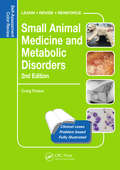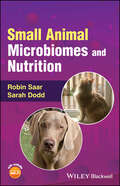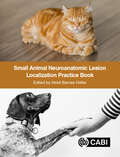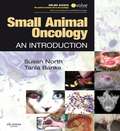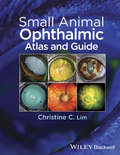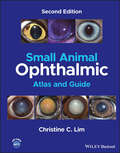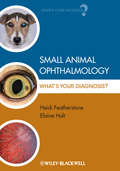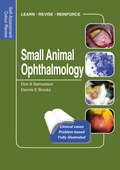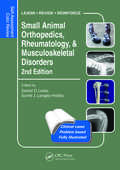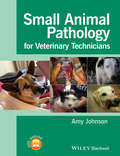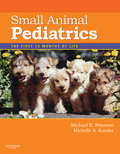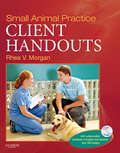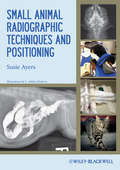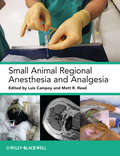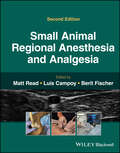- Table View
- List View
Small Animal Medicine and Metabolic Disorders: Self-Assessment Color Review (Veterinary Self-Assessment Color Review Series)
by Craig RuauxKey features: Includes over 150 new, color illustrated cases Covers all aspects of diseases and disorders and affecting organs of the abdominal cavity and the endocrine/metabolic system Written by experts from the USA, Australia, the United Kingdom, and Europe Nearly 20 years after Bryn Tennant's first edition, this new update covers all aspects of diseases and disorders and affecting organs of the abdominal cavity and the endocrine/metabolic system in a case-based format. Responding to advances in imaging technology, digital radiography and high-resolution ultrasonography as well as the growth in specialised diagnostic tests for many diseases, new editor Craig Ruaux brings together a wide variety of new cases. These cases cover a wide spectrum of metabolic, endocrine, immune-mediated, inflammatory and infectious diseases and range in difficulty from simple bacterial infections to complex, multisystem disorders that would challenge most practitioners. They are presented in random order, as they would appear in everyday practice, and each author brings their own specialist expertise and experience to problem identification and management. Presenting an assortment of cases and case-related materials appropriate to the day-to-day practice of small animal medicine, this book will be an essential reference for veterinary students of internal medicine as well as specialists in training.
Small Animal Medicine and Metabolic Disorders: Self-Assessment Color Review (Veterinary Self-Assessment Color Review Series)
by Craig RuauxKey features: Includes over 150 new, color illustrated cases Covers all aspects of diseases and disorders and affecting organs of the abdominal cavity and the endocrine/metabolic system Written by experts from the USA, Australia, the United Kingdom, and Europe Nearly 20 years after Bryn Tennant's first edition, this new update covers all aspects of diseases and disorders and affecting organs of the abdominal cavity and the endocrine/metabolic system in a case-based format. Responding to advances in imaging technology, digital radiography and high-resolution ultrasonography as well as the growth in specialised diagnostic tests for many diseases, new editor Craig Ruaux brings together a wide variety of new cases. These cases cover a wide spectrum of metabolic, endocrine, immune-mediated, inflammatory and infectious diseases and range in difficulty from simple bacterial infections to complex, multisystem disorders that would challenge most practitioners. They are presented in random order, as they would appear in everyday practice, and each author brings their own specialist expertise and experience to problem identification and management. Presenting an assortment of cases and case-related materials appropriate to the day-to-day practice of small animal medicine, this book will be an essential reference for veterinary students of internal medicine as well as specialists in training.
Small Animal Microbiomes and Nutrition
by Robin Saar Sarah DoddSmall Animal Microbiomes and Nutrition Comprehensive resource providing holistic coverage of the effect of body microbiomes on the health status of dogs and cats Small Animal Microbiomes and Nutrition offers new perspective on the prevention and treatment of common health conditions in dogs and cats that arise from or result in dysbiosis of the body’s microbiomes, along with providing alternative first-line solutions of utilizing nutrients—less invasive procedures in comparison to prescription drugs to treat dysbiosis in the body’s microbiomes. This practical manual guides the reader through body systems that are commonly influenced by the microbiota in the microbiomes as well as accompanying dietary recommendations. Initially, an overview of the body’s microbiome including common terminology and functions of microbiomes precede the chapters on development of the body’s microbiomes and factors influencing their diversity and density. The following three sections provide readers with a different perspective of commonly observed health conditions by focusing on the state of the microbiome and how the condition may be prevented and/or treated with the use of nutrients. Written by a highly qualified author with significant experience in the field, Small Animal Microbiomes and Nutrition includes information on sample topics such as: Results of research on alternative diets and emerging ingredients’ effect on the microbiomes and how to have the discussions with pet parents Nutrition focused calculations, feeding directions, and templates for history, and recommendation for follow-up conversations with pet parents Factors affecting the diversity and density of the microbiomes, such as genetics, age, sex, environment, stress, antibiotic therapy, and nutrition Integumentary microbiomes, covering the skin’s microbiome, dysfunctional barrier syndrome, atopy (atopic dermatitis), and key nutritional factors Small Animal Microbiomes and Nutrition is an essential resource for students completing companion animal health courses in two- and four-year programs, particularly those in veterinary technology, veterinary technician, and animal health technology diplomas and degrees, and it is also highly useful for students in other veterinary and animal science focused programs. Additionally, this book is essential in veterinary practices as a reference guide to support the transition into the utilization of microbiome medicine.
Small Animal Microbiomes and Nutrition
by Robin Saar Sarah DoddSmall Animal Microbiomes and Nutrition Comprehensive resource providing holistic coverage of the effect of body microbiomes on the health status of dogs and cats Small Animal Microbiomes and Nutrition offers new perspective on the prevention and treatment of common health conditions in dogs and cats that arise from or result in dysbiosis of the body’s microbiomes, along with providing alternative first-line solutions of utilizing nutrients—less invasive procedures in comparison to prescription drugs to treat dysbiosis in the body’s microbiomes. This practical manual guides the reader through body systems that are commonly influenced by the microbiota in the microbiomes as well as accompanying dietary recommendations. Initially, an overview of the body’s microbiome including common terminology and functions of microbiomes precede the chapters on development of the body’s microbiomes and factors influencing their diversity and density. The following three sections provide readers with a different perspective of commonly observed health conditions by focusing on the state of the microbiome and how the condition may be prevented and/or treated with the use of nutrients. Written by a highly qualified author with significant experience in the field, Small Animal Microbiomes and Nutrition includes information on sample topics such as: Results of research on alternative diets and emerging ingredients’ effect on the microbiomes and how to have the discussions with pet parents Nutrition focused calculations, feeding directions, and templates for history, and recommendation for follow-up conversations with pet parents Factors affecting the diversity and density of the microbiomes, such as genetics, age, sex, environment, stress, antibiotic therapy, and nutrition Integumentary microbiomes, covering the skin’s microbiome, dysfunctional barrier syndrome, atopy (atopic dermatitis), and key nutritional factors Small Animal Microbiomes and Nutrition is an essential resource for students completing companion animal health courses in two- and four-year programs, particularly those in veterinary technology, veterinary technician, and animal health technology diplomas and degrees, and it is also highly useful for students in other veterinary and animal science focused programs. Additionally, this book is essential in veterinary practices as a reference guide to support the transition into the utilization of microbiome medicine.
Small Animal Neuroanatomic Lesion Localization Practice Book
by Susan Arnold Joy Delamaide Gasper Kari Foss Julian Guevar Devon Hague Sam Long Simon Platt Helena RylanderNeuroanatomic lesion localization (detecting where a neurologic problem arises) is key when presented with a dog or cat with signs of neurologic disease. The correct neuroanatomic lesion localization will drive veterinarians towards an appropriate list of differential diagnoses and help lead the client towards applicable diagnostic investigation. Neuroanatomic lesion localization is the first step when managing any pet with signs of neurologic disease. Despite its importance, it remains a challenge for veterinary students, residents and practitioners in their daily practice. Laid out in a case-based format and workbook style to guide the reader through neuroanatomic lesion localization, this book: Covers the whole process from the animal's examination through to diagnosis; Includes localizations of intercranial disease, spinal cord disease, neuromuscular disease and multifocal disease; Provides blank practice sheets to encourage the reader to work through cases, testing and consolidating their knowledge multiple times. Written by a team of eminent, international veterinary neurologists, this book is an invaluable resource for veterinary students and practitioners looking to expand their skills in veterinary neurology.
Small Animal Oncology
by Joanna Morris Jane DobsonNeoplasms are common in dogs and cats and it has been estimated that 50% of dogs and cats aged over 10 years die of neoplasia. The demand for treatment of pets with cancer is increasing and seems likely to do so for the foreseeable future as more animals become insured and their treatment costs are covered. The purpose of this book is to provide a basic clinical approach to the diagnosis and treatment of the more common tumours in dogs and cats for the practising veterinary surgeon, undergraduate student and veterinary nurse. It is not intended to be a comprehensive reference book, covering all aspects of veterinary oncology, since several such texts exist. Rather it seeks to provide a core of basic, easily accessible and clinically relevant information on general aspects of veterinary oncology. The first three chapters present general background information on pathogenesis, tumour biology, managing the cancer patient and the most frequently used methods of treatment. Practical details of chemotherapy and guidance on safety are given, as well as coverage of radiotherapy. The remaining chapters then provide specific information on the epidemiology, aetiology, pathology, presentation, staging, management and prognosis for tumours occurring in the different body systems.
Small Animal Oncology E-Book: An Introduction
by Susan M. North Tania Ann BanksA highly practical guide suitable for in-clinic reference, Small Animal Oncology has been designed for maximum ease of use and accessibility of information. Whilst giving clear and up-to-date briefing for the busy practitioner, it also is a valuable resource to the student with a special interest in oncology. This Introduction gives an overview of cancer biology and explains the principles of available therapies. There is up to date discussion on new and developing techniques and treatments, and guidance on when these are indicated. The book covers all common, most less common and some rare aspects of small animal oncology.accompanying Evolve website includes over 20 clinical cases to try your knowledgeall-round practical, useful, every day essential guide to small animal oncologyschematic approach gives quick access to information when you need itexplains biology and the basic principles as well as indicating treatment options
Small Animal Ophthalmic Atlas and Guide
by Christine C. LimSmall Animal Ophthalmic Atlas and Guide offers fast access to a picture-matching guide to common ophthalmic conditions and key points related to diagnosing and managing these diseases. The first half of the book presents photographs of ophthalmic abnormalities with brief descriptions, as an aid for diagnosis. The second half of the book is devoted to concise, clinically oriented descriptions of disease processes, diagnostic tests, and treatments for each condition. Small Animal Ophthalmic Atlas and Guide is a useful tool for quickly and accurately formulating a diagnosis, diagnostic strategy, and treatment plan for small animal patients. Ideally suited for use in the fast-paced practice setting, this text provides both reference images and information for managing the disease in a single text. Small Animal Ophthalmic Atlas and Guide is an easy-to-use aid for small animal general practitioners, veterinary students, and veterinary interns seeking a quick yet complete guide to small animal ophthalmology.
Small Animal Ophthalmic Atlas and Guide
by Christine C. LimSmall Animal Ophthalmic Atlas and Guide offers fast access to a picture-matching guide to common ophthalmic conditions and key points related to diagnosing and managing these diseases. The first half of the book presents photographs of ophthalmic abnormalities with brief descriptions, as an aid for diagnosis. The second half of the book is devoted to concise, clinically oriented descriptions of disease processes, diagnostic tests, and treatments for each condition. Small Animal Ophthalmic Atlas and Guide is a useful tool for quickly and accurately formulating a diagnosis, diagnostic strategy, and treatment plan for small animal patients. Ideally suited for use in the fast-paced practice setting, this text provides both reference images and information for managing the disease in a single text. Small Animal Ophthalmic Atlas and Guide is an easy-to-use aid for small animal general practitioners, veterinary students, and veterinary interns seeking a quick yet complete guide to small animal ophthalmology.
Small Animal Ophthalmic Atlas and Guide
by Christine C. LimSmall Animal Ophthalmic Atlas and Guide is designed to offer a quick reference to common ocular conditions in dogs and cats, presenting high-quality color photographs to facilitate diagnosis and offering details on each condition to support clinicians in clinical decision making. In addition to updates throughout, the Second Edition includes significantly more images than the previous edition, with updates to images to include more representative examples where possible. In Small Animal Ophthalmic Atlas and Guide, the image section is organized by area of the eye, making it easy to find and compare images to make a diagnosis, and the disease section is carefully targeted to the most crucial details for developing a management plan. A companion website provides video clips. Written by a veterinary ophthalmologist working at a busy urban center, Small Animal Ophthalmic Atlas and Guide includes information on: Orbital disease, including inflammatory and neoplastic disease Eyelid and adnexal disease, such as abnormal hairs (distichiae, ectopic ciliae, and trichiasis), conformational abnormalities (entropion, ectropion, etc.), and third eyelid abnormalities such as gland prolapse Corneal and conjunctival disease, including tear film disorders, causes of keratoconjunctivitis, corneal ulceration, and feline surface ocular disease Anterior uveal conditions, covering uveal cysts, anterior uveitis, and anterior uveal neoplasia Lenticular disease, such as cataract and lens instability The posterior segment, covering normal fundic appearance, chorioretinitis, retinal degeneration, and retinal detachment Recognition and management of glaucoma With its broad coverage of essential topics and accessible images that help with accurate and fast diagnoses, Small Animal Ophthalmic Atlas and Guide is an essential reference for small animal general practitioners, students, residents, and interns, and can also be used as a reference to show examples to clients.
Small Animal Ophthalmic Atlas and Guide
by Christine C. LimSmall Animal Ophthalmic Atlas and Guide is designed to offer a quick reference to common ocular conditions in dogs and cats, presenting high-quality color photographs to facilitate diagnosis and offering details on each condition to support clinicians in clinical decision making. In addition to updates throughout, the Second Edition includes significantly more images than the previous edition, with updates to images to include more representative examples where possible. In Small Animal Ophthalmic Atlas and Guide, the image section is organized by area of the eye, making it easy to find and compare images to make a diagnosis, and the disease section is carefully targeted to the most crucial details for developing a management plan. A companion website provides video clips. Written by a veterinary ophthalmologist working at a busy urban center, Small Animal Ophthalmic Atlas and Guide includes information on: Orbital disease, including inflammatory and neoplastic disease Eyelid and adnexal disease, such as abnormal hairs (distichiae, ectopic ciliae, and trichiasis), conformational abnormalities (entropion, ectropion, etc.), and third eyelid abnormalities such as gland prolapse Corneal and conjunctival disease, including tear film disorders, causes of keratoconjunctivitis, corneal ulceration, and feline surface ocular disease Anterior uveal conditions, covering uveal cysts, anterior uveitis, and anterior uveal neoplasia Lenticular disease, such as cataract and lens instability The posterior segment, covering normal fundic appearance, chorioretinitis, retinal degeneration, and retinal detachment Recognition and management of glaucoma With its broad coverage of essential topics and accessible images that help with accurate and fast diagnoses, Small Animal Ophthalmic Atlas and Guide is an essential reference for small animal general practitioners, students, residents, and interns, and can also be used as a reference to show examples to clients.
Small Animal Ophthalmology: What's Your Diagnosis? (What's Your Diagnosis? #3)
by Heidi Featherstone Elaine HoltSmall Animal Ophthalmology: What's Your Diagnosis? is one of the first books in an exciting new series that combines problem-based learning, case studies, and questions and answers. Designed specifically for veterinarians and students, the series aims to present material in a format to enhance critical thinking and understanding. Adopting a case-based approach, chapters are built around common ophthalmic presentations and are directed by questions to test the reader's ability to interpret clinical history, ophthalmic photographs and diagnostic results in order to provide differential diagnoses, diagnostic plans and treatment options. For veterinary students, this book is an ideal guide to how ophthalmology cases are handled in the clinical setting. For veterinary practitioners, it is an innovative and interesting way to increase their knowledge and skills in clinical ophthalmology.
Small Animal Ophthalmology: What's Your Diagnosis? (What's Your Diagnosis? #2)
by Heidi Featherstone Elaine HoltSmall Animal Ophthalmology: What's Your Diagnosis? is one of the first books in an exciting new series that combines problem-based learning, case studies, and questions and answers. Designed specifically for veterinarians and students, the series aims to present material in a format to enhance critical thinking and understanding. Adopting a case-based approach, chapters are built around common ophthalmic presentations and are directed by questions to test the reader's ability to interpret clinical history, ophthalmic photographs and diagnostic results in order to provide differential diagnoses, diagnostic plans and treatment options. For veterinary students, this book is an ideal guide to how ophthalmology cases are handled in the clinical setting. For veterinary practitioners, it is an innovative and interesting way to increase their knowledge and skills in clinical ophthalmology.
Small Animal Ophthalmology: Self-Assessment Color Review (Self-assessment Color Review Ser.)
by Don Samuelson Dennis BrooksThis book provides systematic coverage of small animal ophthalmology via randomized self-assessment case presentations: integrated questions, superb illustrations, color photos, imaging, diagrams, tables, and detailed explanatory answers. The authors have emphasize the more common ophthalmic conditions presented to veterinarians in practice with 25
Small Animal Ophthalmology: Self-Assessment Color Review
by Don Samuelson Dennis BrooksThis book provides systematic coverage of small animal ophthalmology via randomized self-assessment case presentations: integrated questions, superb illustrations, color photos, imaging, diagrams, tables, and detailed explanatory answers. The authors have emphasize the more common ophthalmic conditions presented to veterinarians in practice with 25
Small Animal Orthopedics, Rheumatology and Musculoskeletal Disorders: Self-Assessment Color Review 2nd Edition
by Daniel Lewis Sorrel J. Langley-HobbsThe practice of small animal orthopedics has advanced considerably in the 15 years since the publication of the first edition of Self-Assessment Color Review of Small Animal Orthopedics. Diagnostic procedures, instrumentation, implant systems, and surgical techniques have evolved and progressed considerably. This second edition of a trusted text ke
Small Animal Pathology for Veterinary Technicians
by Amy JohnsonSmall Animal Pathology for Veterinary Technicians fosters an understanding of small animal diseases, relating pathology information to the responsibilities of technicians in the clinical setting. Beginning with the technician’s role in pathology, terminology, and the process of diagnosis, chapters then cover diseases organized by system. From reproductive, endocrine, and eye disease to urinary tract and infectious diseases, the book offers in-depth information on a wide range of commonly presented diseases, providing technicians with practical information linked to their daily tasks. Each body system includes a brief review of anatomy and function, full-color pictures, and tip boxes to help emphasize important issues. A companion website offers images from the book, review questions, and case studies illustrating the process of handling the patient at www.wiley.com/go/johnsonvettechpath. Veterinary technician students and veterinary technicians in practice will find this a valuable resource to understanding disease and the process of diagnosis.
Small Animal Pathology for Veterinary Technicians
by Amy JohnsonSmall Animal Pathology for Veterinary Technicians fosters an understanding of small animal diseases, relating pathology information to the responsibilities of technicians in the clinical setting. Beginning with the technician’s role in pathology, terminology, and the process of diagnosis, chapters then cover diseases organized by system. From reproductive, endocrine, and eye disease to urinary tract and infectious diseases, the book offers in-depth information on a wide range of commonly presented diseases, providing technicians with practical information linked to their daily tasks. Each body system includes a brief review of anatomy and function, full-color pictures, and tip boxes to help emphasize important issues. A companion website offers images from the book, review questions, and case studies illustrating the process of handling the patient at www.wiley.com/go/johnsonvettechpath. Veterinary technician students and veterinary technicians in practice will find this a valuable resource to understanding disease and the process of diagnosis.
Small Animal Pediatrics - E-Book: The First 12 Months of Life
by Michael E. Peterson Michelle KutzlerA practical reference for the general veterinary clinician, Small Animal Pediatrics: The First 12 Months of Life compiles into a single location the latest information in the rapidly developing field of canine and feline pediatrics. Editors Michael Peterson, DVM, MS, and Michelle Kutzler, DVM, PhD, DACT are joined by more than 40 expert contributors in providing coverage from prenatal care to one year of age. For ease of use, the text is divided into four sections. A General Considerations section opens the book by covering prenatal care of the bitch and queen, birth, normal physical examinations, growth, husbandry, nutrition, care of orphans, neonatal mortality, behavior, emergency and critical care, and immunology. The second section, Common Infectious Diseases, covers bacterial, viral, fungal, rickettsial, and parasitic infections. The third section describes diagnostic and therapeutic approaches to the young patient including radiology, ultrasound, aesthetic and surgical considerations, pain management, pharmacology, and clinical pathology. Finally, the fourth section covers a variety of organ systems with discussions on normal development, congenital conditions, and acquired diseases. The text also includes information that is usually difficult to find, including a pediatric formulary, care of orphan puppies, clinical pathology values, prenatal care, and normal growth and development guidelines. This book will be a significant asset to any veterinary library!Offers a practical, clinically oriented resource for the unique diagnostic and treatment challenges posed by pediatric and juvenile animal patients.Includes comprehensive coverage of all special problems encountered in pet management from birth through the first 12 months of life.Provides clear, step-by-step guidelines for important clinical procedures and techniques for the most vulnerable of small animal patients.Covers procedures such as intraosseous catheterization and fluid therapy, venipuncture, and tube feeding.Includes guidelines for designing and implementing a successful pediatric wellness program tailored to your own practice.Discusses infectious diseases in young animals, zoonotic potential, and human public health concerns.Provides key new information on puppy and kitten behavioral development including guidance for prevention and intervention for problem behaviors, the leading cause of pet euthanasia.Includes guidelines for kennel and cattery health management as well as shelter medicine health considerations.Discusses controversial health and ethical issues in veterinary pediatrics, such as ear cropping, tail docking, declawing, and early spay/neuter surgery (including both pro and con positions).Includes the latest recommendations for nutritional care of healthy and "special needs" puppies and kittens as well as the post-parturient and nursing dam.Offers an easy-to-use, well-organized format for quick and easy access to the most relevant information.
Small Animal Practice Client Handouts - E-Book
by Rhea V. MorganMorgan’s Small Animal Practice Client Handouts combines a book and CD-ROM to include 450 educational handouts that cover everything your clients need to know about their pet’s condition. Content ranges from basic descriptions of illnesses and frequent signs to preventive measures and expected outcomes, all on a single page. Give your clients an educational resource to help them understand what their pet’s illness is, how it will affect the animal’s regular routine (as well as their own), and when they need to contact the veterinary office for consultation.CD can be uploaded to more than one computer allowing for simultaneous use in the exam room and/or front desk. Single page handouts are presented in a practical, easy-to-understand format that does not overwhelm the client. Perforated pages facilitate easy storage, retrieval, and quick access for copying. Organized alphabetically and by body system enabling you to quickly locate the information you need. Customizable handouts on the CD let you adapt the look and content of all documents to reflect the practice’s identity and address specific concerns of each client. Spanish versions on the CD help you communicate with Spanish-speaking clients. Advanced search function on the CD lets you search for information by topic, species, word, or phrase. 100 printable images on the CD facilitate discussion with clients about their pet’s condition and save you time in explanation.
Small Animal Radiographic Techniques and Positioning
by Susie AyersSmall Animal Radiographic Techniques and Positioning is a practical, clinically applicable manual designed to aid veterinary technicians and nurses in correcting common artifacts in both film and digital radiography and in positioning the small animal patient for clear and consistent radiographs. Detailed positioning techniques are provided for each commonly radiographed body segment, including positioning aids, alternative restraint methods, and examples of the corresponding correct or incorrect radiographs. Species covered include dogs, cats, birds, and common exotics. The book begins with an overview of radiographic technique, darkroom maintenance, digital and film-screen imaging, then offers a section on small animal positioning, including some exotic species positioning techniques, with the final section presenting information on contrast media and special contrast enhanced procedures. A companion website provides the images from the book in PowerPoint and study questions and answers at www.wiley.com/go/ayers. Highly illustrated, Small Animal Radiographic Techniques and Positioning is a complete resource for any veterinary technician or student to quickly find imaging information and improve the clarity of small animal radiographs.
Small Animal Radiographic Techniques and Positioning
by Susie AyersSmall Animal Radiographic Techniques and Positioning is a practical, clinically applicable manual designed to aid veterinary technicians and nurses in correcting common artifacts in both film and digital radiography and in positioning the small animal patient for clear and consistent radiographs. Detailed positioning techniques are provided for each commonly radiographed body segment, including positioning aids, alternative restraint methods, and examples of the corresponding correct or incorrect radiographs. Species covered include dogs, cats, birds, and common exotics. The book begins with an overview of radiographic technique, darkroom maintenance, digital and film-screen imaging, then offers a section on small animal positioning, including some exotic species positioning techniques, with the final section presenting information on contrast media and special contrast enhanced procedures. A companion website provides the images from the book in PowerPoint and study questions and answers at www.wiley.com/go/ayers. Highly illustrated, Small Animal Radiographic Techniques and Positioning is a complete resource for any veterinary technician or student to quickly find imaging information and improve the clarity of small animal radiographs.
Small Animal Regional Anesthesia and Analgesia
by Luis CampoySmall Animal Regional Anesthesia and Analgesia is an up-to-date, complete resource for performing local anesthetic techniques in small animals. This practical, clinically oriented reference presents step-by-step procedures for performing common locoregional blocks and is organized logically by body system. The first book to draw information on this topic into one resource, Small Animal Regional Anesthesia and Analgesia is equally useful as a comprehensive reference and as a quick source of information with checklists and pictures to assist with performing various blocks in practice. Beginning with introductory sections offering an overview of general considerations for patient preparation and pharmacology, the heart of the book is devoted to detailed instructions for performing regional anesthetic techniques, including reviews of the literature, useful illustrations, diagrams, and clinical tips. Small Animal Regional Anesthesia and Analgesia provides an invaluable tool for veterinary anesthesiologists and practitioners who incorporate local and regional anesthetic techniques into their small animal practices.
Small Animal Regional Anesthesia and Analgesia
by Luis Campoy Matt ReadSmall Animal Regional Anesthesia and Analgesia is an up-to-date, complete resource for performing local anesthetic techniques in small animals. This practical, clinically oriented reference presents step-by-step procedures for performing common locoregional blocks and is organized logically by body system. The first book to draw information on this topic into one resource, Small Animal Regional Anesthesia and Analgesia is equally useful as a comprehensive reference and as a quick source of information with checklists and pictures to assist with performing various blocks in practice. Beginning with introductory sections offering an overview of general considerations for patient preparation and pharmacology, the heart of the book is devoted to detailed instructions for performing regional anesthetic techniques, including reviews of the literature, useful illustrations, diagrams, and clinical tips. Small Animal Regional Anesthesia and Analgesia provides an invaluable tool for veterinary anesthesiologists and practitioners who incorporate local and regional anesthetic techniques into their small animal practices.
Small Animal Regional Anesthesia and Analgesia
by Matt Read Luis Campoy Berit FischerSmall Animal Regional Anesthesia and Analgesia Explore regional techniques for anesthesia and analgesia in dogs and cats in this thoroughly expanded and revised edition of the most comprehensive book on the topic Small Animal Regional Anesthesia and Analgesia, Second Edition expands and updates the information in the first edition, making this a truly comprehensive and practical reference for regional anesthetic techniques in dogs and cats. Written by leading international experts in the field, this book provides an authoritative yet practical guide to using ultrasound-guided local and regional anesthesia techniques in clinical practice. Grounded in the latest scientific literature, the book presents a wealth of new or updated information, and incorporates a logical, standardized format and high-quality color images, making it easier and faster to find information about each block. Small Animal Regional Anesthesia and Analgesia, Second Edition: Provides an expanded and updated new edition of this practical, clinically-oriented resource, with step-by-step details for each procedureFeatures more images to support the visual aspect of learning that is necessary when using ultrasound to perform locoregional anesthesiaHas been reorganized to present information based on the individual technique, rather than the general anatomical region of the body Small Animal Regional Anesthesia and Analgesia, Second Edition is a must-have reference for veterinary practitioners and specialists.
